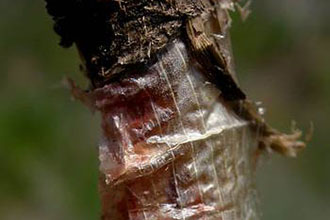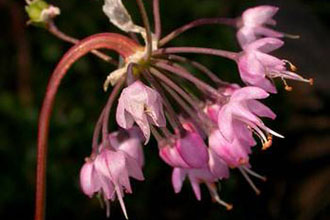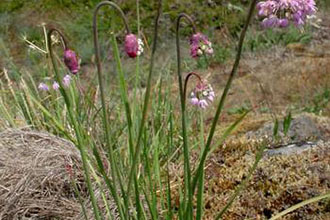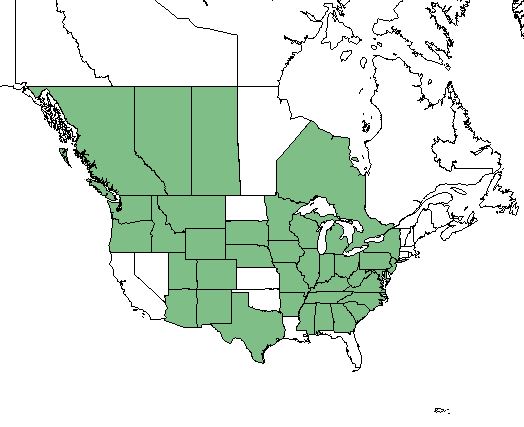General: Perennial herb from an elongate, long-necked, narrowly egg-shaped, scaly bulb, the outer scales membranous, without a fibrous network, the inner scales faintly pinkish, the bulbs often clustered; flowering stems erect but down-curved near the top, 10-50 cm tall, slender, often somewhat angled, smooth.
Has 2-5+ bulbs, clustered, often short-rhizomatous at base, rhizome not stout or iris-like, oblong, elongate, 1–3 × 0.8–1.5 cm; outer coats enclosing 1 or more bulbs, grayish or brownish, membranous, minutely striate, cells in regular vertical rows, narrowly elongate, fibers persistent, parallel, few; inner coats white to pink or reddish, cells in regular vertical rows, narrowly elongate. Leaves persistent, green at anthesis, 3–5, basally sheathing, sheaths not extending much above soil level; blade solid, flat, channeled to broadly V-shaped in cross section, 10–25 cm × 1–6 mm, margins entire or denticulate. Scape persistent, sometimes 2 or more produced successively from single bulb, usually clustered, nodding, solid, terete or ridged, particularly distally, sometimes flattened and narrowly winged, abruptly recurved near apex, 10–50 cm × 1–3 mm. Umbel persistent, cernuous, loose, 8–35-flowered, hemispheric, bulbils unknown; spathe bracts persistent, 2, 3-veined, lanceolate, ± equal, apex acuminate, beakless. Flowers campanulate, 4–6 mm; tepals ± erect, pink or white, elliptic-ovate, ± equal, withering in fruit, margins ± entire, apex ± obtuse, at least outer tepals strongly incurved, midribs not thickened; stamens exserted; anthers yellow; pollen yellow; ovary conspicuously crested; processes 6, flattened, ± triangular, margins entire or toothed; style exserted, linear, ± equaling stamens; stigma capitate, scarcely thickened, unlobed; pedicel 6–25 mm, becoming stouter in fruit, elongating and bending abruptly upward from near point of attachment. Seed coat dull or shining; cells smooth, minutely roughened, or each with minute, central papilla.
Leaves: Basal leaves several per bulb, linear, flat to channeled, shorter than the flowering stem, about 3 mm wide, smooth, the margins entire or minutely toothed; stem leaves lacking.
Flowers: Inflorescence a compact, terminal, nodding umbel of several to many, stalked flowers, above 2 membranous bracts, the stalks 1-3 cm long, the bracts soon deciduous; flowers pink to rose-purple or whitish, bell-shaped, of 6 distinct tepals, the tepals 4-6 mm long, elliptic-egg-shaped, blunt; stamens 6, exserted; pistil 1, 3-chambered.
Fruits: Capsules, more or less egg-shaped, 3-lobed, with 6 crests, 2 on each lobe; seeds 6 or fewer, dull-black.



